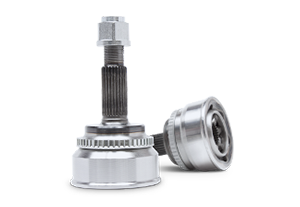CV Axle Inspection
Recognizing potential problems early can help prevent more expensive and expansive repairs on your CV axle. Trouble turning and resistance from tires while maneuvering are signs of CV axle issues. A bad CV axle will emit noise, such as squeaking that increases with speed. Vibrations that increase with speed and vibrating floorboards are also signs that your CV axle should be inspected by our service staff. While an inspection of the CV axle is centered on checking the axle, our inspectors may find problems related to CV joints or CV boots. Because the CV axle components combine into one working assembly, reviewing proper working conditions for all components is extremely important for CV axle maintenance. Our CV axle inspection can help keep major repairs or replacements at bay.
CV Axle Replacement
CV axles were once primarily used on front-wheel drive vehicles. Today, CV axles are common on both front-wheel and rear-wheel drive vehicles. The CV axle assembly—the axle shaft, CV joints, and CV boots—is designed to flexibly deliver power to the wheels for a seamless transfer of torque. Located between the drive wheels, the CV axle, along with the suspension system, compensates for irregularities in the road and transmits torque to the wheels while keeping them turning at a constant velocity. The CV axle is attached to the wheels by CV joints. The inner CV joints connect the transmission to the CV axle while the outer CV joints connect the CV axle to the wheels. A fully functional CV axle assembly provides your vehicle with safety and stability while supporting passenger comfort through various speeds and driving conditions.
CV Boot Replacement
Since your CV boot keeps your CV joint properly lubricated, any splits in the CV boot will lead to a loss of lubrication. The resulting metal on metal contact can wear down your CV joints fairly quickly. You should also note that heat and friction can eventually degrade your CV boot. Because CV boots also keep the area of lubrication clean and prevent any damaging dirt or debris from harming the CV joint, replacing a cracked or torn CV boot as soon as possible is extremely important. Our visual inspection will determine whether or not the boot needs to be replaced. Our CV boot replacement will help the CV joint stay properly lubricated and help ensure proper transfer of motion from the transmission to the wheels. Neglecting regular inspections of the CV boot and accompanying components may lead to more expensive repairs and replacements down the road.
CV Joint Replacement
As a CV joint loses lubrication, the moving metal parts wear on one another and slowly degrade over time. Noises, vibrations, and loss of acceleration through turns are all signs that a CV joint may require a replacement. Another problem that might lead to a CV joint replacement is your CV boot. The CV boot encases the CV joint to retain the necessary amount of grease to keep the joint lubricated. If the grease leaks, the CV joint will lose the proper amount of lubrication necessary to keep the internal CV joint parts from excessive wear. If you experience the symptoms of a worn or damaged CV joint and the joint is not promptly replaced, the minor issue will cause additional damage to your vehicle and lead more expensive repairs in the future. The cost of replacing your CV joint is cheaper than the major repairs you may face if a faulty CV joint is left untreated.
U-Joint Replacement
Clicking, squeaking, and grinding noises while driving are warning signs that your u-joints may require replacement. The cost of replacing your u-joint can be cheaper than the major repairs you may face if a worn u-joint is left untreated. Vibrations and rattling noises are key indicators of a faulty u-joint. Grinding noises may be an indication of metal on metal, which will cause u-joints to wear out quickly. Because they are subject to torque and force from the engine, u-joints may bend. On older vehicles, u-joints will rust, adding surface resistance onto the joints, making them less able to turn as they once did. Routine inspections of your u-joints have been known to prevent more expensive repairs. Replacing your u-joints at the first sign of trouble will also help prevent failure in your vehicle’s driveline. When you need new u-joints, give us a call.
Yoke Replacement
Do you know if one of your yokes needs a replacement? There are some indications. For example, clunking noises are often related to a problem with your vehicle’s yokes. Vibrations felt beneath the floorboard of your vehicle may also be a signal of a damaged yoke. In some cases there may be too much free play or an excessive amount of clearance. Under an excessive amount of stress, a yoke can crack or snap completely. Sometimes, the transmission can twist the yoke. Broken, bent, and twisted yokes should be replaced immediately. If you are experiencing any of the above symptoms, contact us today for an inspection of your vehicle’s driveshaft assembly and a possible yoke replacement service.



